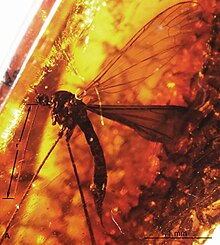Sunday, 23 August 2015
Elephantomyia (Elephantomyia) brevipalpa is AN extinct species of dipterous insect within the family Limoniidae. The species is entirely noted from the center Eocene Baltic amber deposits within the Baltic region of Europe. The species is one amongst six represented from Baltic amber.
The fossil was initial studied by animal scientist Arminius Loew of the Deutschland, along with his kind description of the new species being revealed in 1851 as Toxorhina brevipalpa, although he revealed the nomen nudum name a year earlier. The species was emotional to the genus Limnobiorhynchus in 1860 by Carl Robert Osten-Sacken, and later emotional by Osten-Sacken once more, now to the genus Elephantomyia. The fossil was reexamined and therefore the species redescribed in 2015 by paleoentomologist Iwona Kania of the University of Rzeszów, United Nations agency examined the example and therefore the 2 further specimens.
Paste your text here and click on "Next" to look at this text redactor do it's issue.
don't have any text to check? don't have any text to check? Click "Select Samples"
| Elephantomyia brevipalpa Temporal range: Middle Eocene | |
|---|---|
 | |
| E. (E.) brevipalpa female | |
| Scientific classification | |
| Kingdom: | Animalia |
| Phylum: | Arthropoda |
| Class: | Insecta |
| Order: | Diptera |
| Family: | Limoniidae |
| Genus: | Elephantomyia |
| Species: | †E. brevipalpa |
| Binomial name | |
| Elephantomyia brevipalpa (Loew, 1850) | |
| Synonyms | |
| |
History and classification
Elephantomyia (Elephantomyia) brevipalpa is thought from the example specimen, assortment variety MB.J.337, together with 2 more adults that area unit preserved as inclusions in clear Baltic amber. As of 2015, 2 of the amber specimens were enclosed within the collections of the University of Göttingen, whereas the third was housed at the Polish Academy of Sciences. Baltic amber is recovered from fossil bearing rocks within the Baltic Sea region of Europe. Estimates of the age date between thirty seven million years recent, for the youngest sediments and forty eight million years recent. This age vary straddles the center epoch, starting from close to the start of the Lutetian to the start of the Pribonian. E. brevipalpa is one among six dipteran species within the genus Elephantomyia represented from the Baltic amber, the others being E. baltica, E. bozenae, E. irinae, E. longirostris, and E. pulchella. All six species area unit placed into the Elephantomyia taxon Elephantomyia supported the shortage of leg bone spurs and by many aspects of the wing morphology.The fossil was initial studied by animal scientist Arminius Loew of the Deutschland, along with his kind description of the new species being revealed in 1851 as Toxorhina brevipalpa, although he revealed the nomen nudum name a year earlier. The species was emotional to the genus Limnobiorhynchus in 1860 by Carl Robert Osten-Sacken, and later emotional by Osten-Sacken once more, now to the genus Elephantomyia. The fossil was reexamined and therefore the species redescribed in 2015 by paleoentomologist Iwona Kania of the University of Rzeszów, United Nations agency examined the example and therefore the 2 further specimens.
Paste your text here and click on "Next" to look at this text redactor do it's issue.
don't have any text to check? don't have any text to check? Click "Select Samples"


0 comments:
Post a Comment